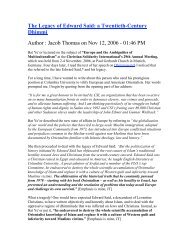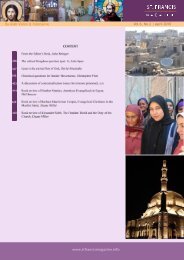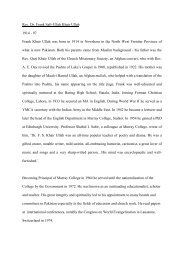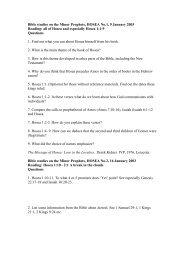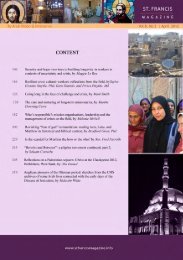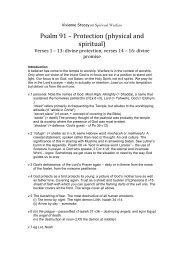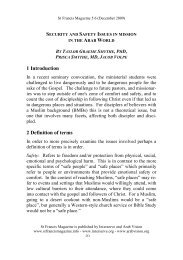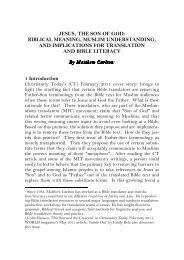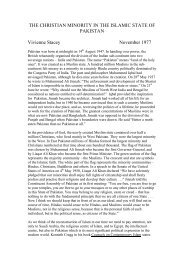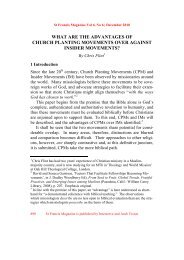download the pdf - St.Francis Magazine
download the pdf - St.Francis Magazine
download the pdf - St.Francis Magazine
Create successful ePaper yourself
Turn your PDF publications into a flip-book with our unique Google optimized e-Paper software.
<strong>St</strong> <strong>Francis</strong> <strong>Magazine</strong> Vol 8, No 4 | August 2012<br />
2000). Clearly <strong>the</strong>re were great hopes, and prospects, for discipling<br />
Muslim peoples in <strong>the</strong> new century (Love 2000), even if methods for<br />
such evangelism were not clear (Brown 2000b; <strong>St</strong>einhaus 2000) and<br />
<strong>the</strong> results of <strong>the</strong> search for biblical precedents was mixed, even<br />
contrary.<br />
This state of missiological flux - combined with <strong>the</strong> sustained sea<br />
changes in mission practice and sensibilities perceived as arising<br />
after 9/11 (Richard 2001; Woodberry 2002; Love 2008a) and debates<br />
surrounding field-governed mission structures in subsequent<br />
issues of IFJM (issues 18(2) and 18(3)) - created fur<strong>the</strong>r conditions<br />
to sustain ferment concerning C5 as a strategy. On <strong>the</strong> one hand,<br />
<strong>the</strong>re was <strong>the</strong> claim that “more Muslims have come to Christ in <strong>the</strong><br />
last 25 years than in <strong>the</strong> entire history of Muslim missions combined”<br />
(Love 2000: 5) but, never<strong>the</strong>less, many felt that, in <strong>the</strong> face of<br />
ongoing pressing need for a gospel impact amongst Muslim peoples,<br />
“[i]t would be naive to expect <strong>the</strong>se churches [C1 and C2] to<br />
make any significant breakthrough among Muslims.” (Tennent<br />
2006: 103)<br />
These early articulations of C5 ministries amongst Muslims<br />
were fur<strong>the</strong>r fed by parallel developments in o<strong>the</strong>r, non-Muslim<br />
mission fields. In particular, Hoefer’s book-length discussion of<br />
‘Churchless Christianity’ claimed that, in Madras, 200,000 nonbaptised<br />
Jesu bhakta, Hindu devotees of Jesus, continued to live within,<br />
and identify <strong>the</strong>mselves with, Hindu society (Hoefer 2001; cf. Hoefer<br />
2002). In a parallel development, Richard (2004: 316-320) proposed<br />
a seven-point ‘H-Scale for Hindu Contextualization.’ Clearly, <strong>the</strong><br />
debate was set to continue.<br />
2.3 2003-2007: Development and Dispute<br />
As C5 praxis developed, so too did its literature and, with it, reactions<br />
against its proposals and underlying rationale.<br />
At this juncture, it is helpful to introduce <strong>the</strong> parallel concept of<br />
‘insider movements’ into this discussion of C5 developments. Garrison<br />
(2004) was among <strong>the</strong> first to make use of this terminology in<br />
print, although <strong>the</strong> categories of ‘insider’ and ‘outsider’ underpinned<br />
Travis’ C1-C6 spectrum and <strong>the</strong> concept was broached in 1970s lit-<br />
<strong>St</strong> <strong>Francis</strong> <strong>Magazine</strong> is a publication of Interserve and Arab Vision 465




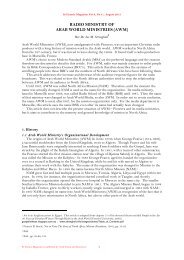
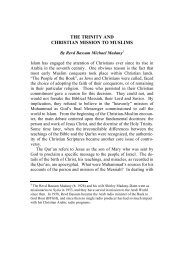
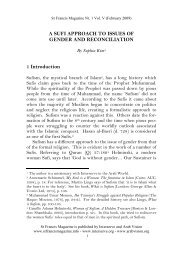
![Reflections on Surah Fatiha and the Lord's Prayer[1] - St.Francis ...](https://img.yumpu.com/49377951/1/184x260/reflections-on-surah-fatiha-and-the-lords-prayer1-stfrancis-.jpg?quality=85)
